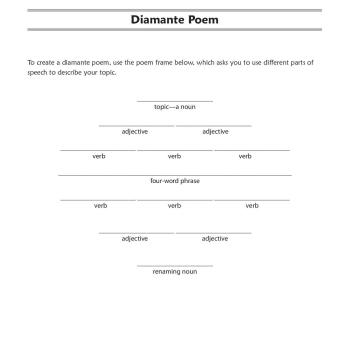Diamante Poem

About this printout
This tool will allow your students to create a diamante poem by reflecting on their knowledge of a topic and by using nouns, verbs, and adjectives in a creative manner.
Teaching with this printout
Poetry can be integrated into a variety of subject areas. Students in grades 3–8 often write many different kinds of poetry but may be unfamiliar with a diamante poem. Before distributing this tool, be sure to model a diamante poem ahead of time. Once students understand the format, they can use a diamante poem to describe any number of curriculum topics.
Line 1: one-word topic (a noun)
Line 2: two adjectives
Line 3: three verbs
Line 4: a four-word phrase
Line 5: three verbs
Line 6: two adjectives
Line 7: a renaming noun for the topic
More ideas to try
- Review parts of speech before having students engage in the writing of diamante poems. While your students are likely familiar with what a noun is, take time to discuss the term “renaming noun.” Provide an example, such as, “a renaming noun for ‘cloud’ could be ‘puffball.’” Also review adjectives and verbs.
- Older or more advanced students may want to take on a more challenging diamante poem. Rather than just addressing one object, this poem begins with one object and then transforms into a different but somewhat related object. For example, begin with an object, such as a pencil. The first half of the poem describes the pencil. Then the poem describes another different, but related, object, such as a pen. See the following example:
Pencil
Sharp, No. 2
Writing, scribbling, erasing
A means of communication
Scribbling, copying, signing
Plastic, inky
Pen
- Adapt the diamante printable so it can be used as a means of telling about a book students are reading. Students create a diamante poem by listing the name of the book, the main character and secondary characters, story events, conflict and resolution, and the overall genre of the book. See the following model:
Line 1: title of the book
Line 2: main character
Line 3: secondary characters
Line 4: initial conflict in the book
Line 5: important events that happened
Line 6: how the conflict was resolved
Line 7: book’s genre